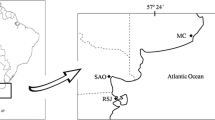Abstract
Variations in the biochemical composition (protein and cholesterol) have been studied in the hepatopancreas and thoracic muscle of the crab, Sesarma boulengeri as a function of sex and size. Second degree polynomial regression equations are used in predictive fashion to quantify the biochemical constituents in relation to sex and size. The effect of size is expressed as a power function of body weight. A good agreement is found between the experimental data and the theoretical values based on the polynomial.
There is a negative correlation between the mass of crab and the reduced mass of cholesterol and protein of the tissues in both sexes, signifying higher metabolic and growth rates in younger crabs. The cholesterol and protein contents are higher in the male indicating more growth than in the female. However, there is tendency of the muscle protein to increase in large sized female crabs suggesting that bigger sized female are structurally better suited than males.
Similar content being viewed by others
References
Burggren, W. Warren. 1975. Oxygen consumption as function of size in a terrestrial hermit crab, Coenobita (Decapoda, Paguridea). Crustaceana., 28: 314–316.
Florkin, M. 1960. Ecology and Metabolism, in: The Physiology of Crustacea (Edit. T. H. Waterman), Vol. 1. Academic Press, New York, pp. 395–410.
Florkin, M. & Schoffeniels, E. 1965. Euryhalinity and the concept of physiological radiation, in: Studies on Comparative Biochemistry (Edit. K. A. Munday), Pergamon Press, London. pp. 6–40.
Fowler, S. W., Small, L. F. & Keckes, S. 1971. Effects of temperature and size on molting of euphasiids crustaceans. Mar. Biol., 11: 45–51.
Gerard, J. F. & Gilles, R. 1972. The free amino acid pool in Callinectes sapidus (Rathbum) tissues and its role in the osmotic intracellular regulation. J. Exp. Mar. Biol. Ecol., 10: 125–136.
Heath, J. R. & Barnes, H. 1970. Some changes in biochemical composition with season and during the molting cycle of the common shore-crab, Carcinus maenas (L). J. Exp. Mar. Biol. Ecol., 5: 199–223.
Hemmingsen, A. M. 1960. Energy metabolism as related to body size and respiratory surface and its evolution. Rep. Steno. Hosp. Copenhagen., 9: 7–1 10.
Jawed, M. 1973. Effects of environmental factors and body size on rates of oxygen consumption in Archaeomysis grebnitzkii and Neomysis awatschensis (Crustacea: Mysidae). Mar. Biol., 21: 173–179.
Layne, E. 1957. Spectrophotometric methods of measuring proteins: Methods in Enzymology (Eds. Colowick, S. P. & N. O. Kaplan, Vol. Ill. Academic Press, New York. pp. 448–450.
Maynard, D. M. 1960. Circulation and Heart Function, in: The Physiology of Crustacea (Edit. T. H. Waterman), Vol. 1. Academic Press, New York. pp. 161–226.
Orton, J. H. 1936. Experiments in sea on the rate of growth of some crustacean decapods. J. Mar. Biol. Assoc. U.K., 20: 673–689.
Padmanabhanaidu, B. & Ramamurthi, R. 1961. The influence of sex and size on the osmotic pressure, the chloride and free amino acids of the blood of the freshwater field crab, Paratelphusa sp. and the freshwater mussel, Lamellidens marginalis. J. Exp. Biol. 38: 35–41.
Prosser, C. L. 1973. Comparative Animal Physiology, W. B. Saunders Company, Philadelphia.
Ramamurthi, R. 1966. Succinic dehydrogenase activity in a freshwater crab, in relation to salinity stress. Comp. Bioehem. Physiol., 19: 645–648.
Ramamurthi, R. 1967. Oxygen consumption of a freshwater field crab, Paratelphusa hydrodromous in relation to salinity stress. Comp. Biochem. Physiol., 23: 599–606.
Renaud, L. 1949. Le cycle des reserves organiques chez les Crustacés Decapodes. Ann. Inst. Oceanog. (Paris)., 24: 259–357.
Sutherland, E. W., Cori, C. F. Haynes, R. & Olsen, N. S. 1949. Purification of the hyperglycemic glyeogenolytic factor from insulin and from gastric mucosa. J. Biol. Chem., 180: 825–837.
Varley, H. 1967. Lipids. In: Practical Clinical Biochemistry (H. Varley, ed.) pp. 309–326. Heinemann, London & Wiley (Interscience), New York.
Vonk, H. J. 1960. Digestion and Metabolism, in: The Physiology of Crustacea (Edit. T. H. Waterman), Vol. I. Academic Press, New York. pp. 291–316.
Zeuthen, E. 1953. Oxygen uptake as related to body size in organism. Quart. Rev. Biol., 28: 1–12.
Author information
Authors and Affiliations
Rights and permissions
About this article
Cite this article
Sinha, R.C., Ahmed, H.K. Some changes in biochemical composition with sex and size of the crab, Sesarma boulengeri calman. Hydrobiologia 61, 15–19 (1978). https://doi.org/10.1007/BF00019020
Received:
Issue Date:
DOI: https://doi.org/10.1007/BF00019020



